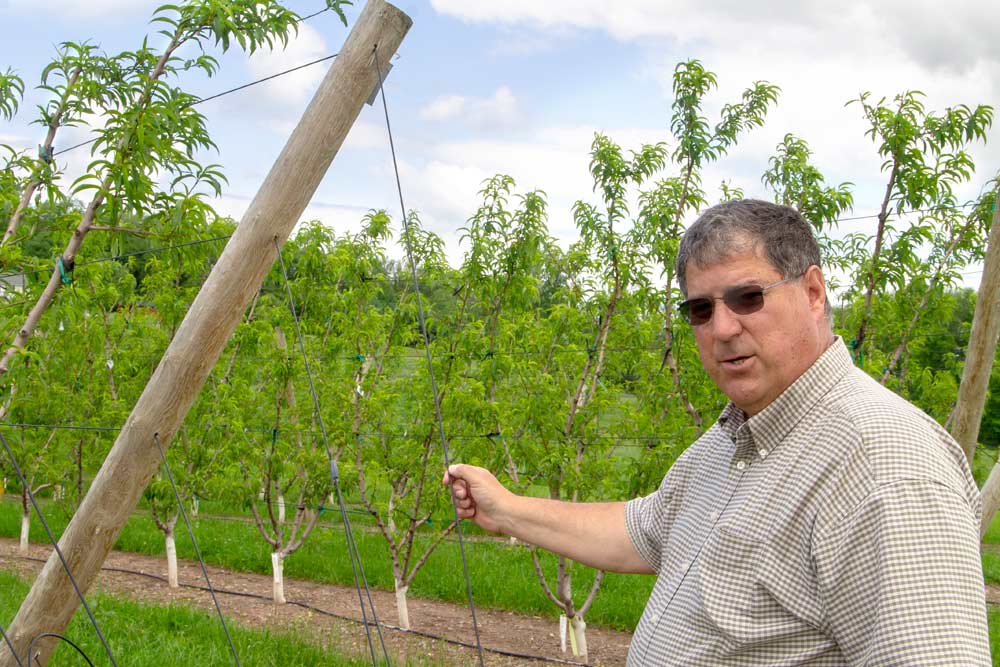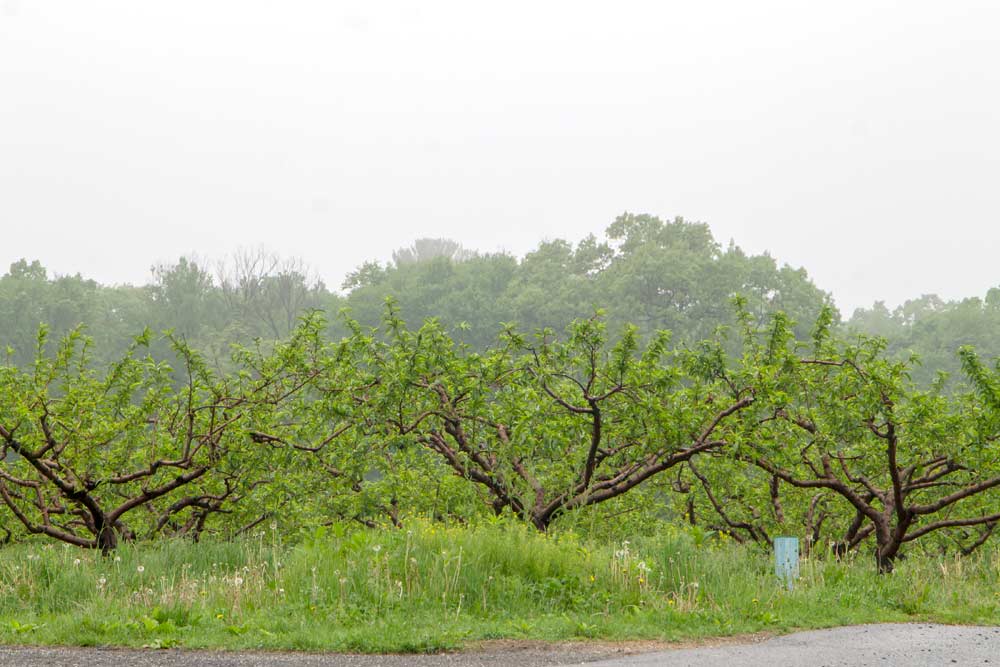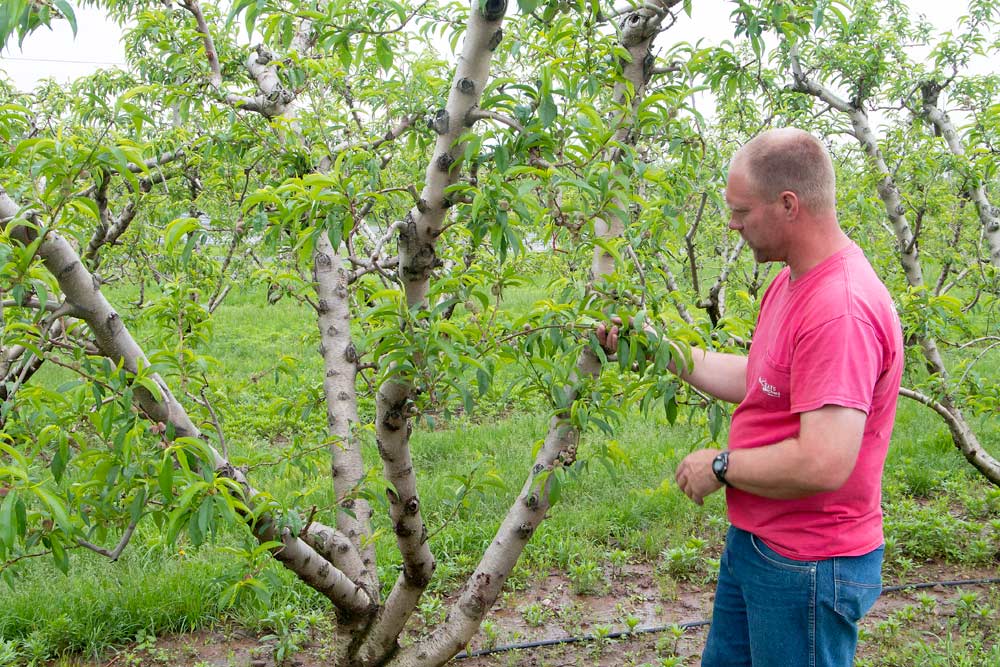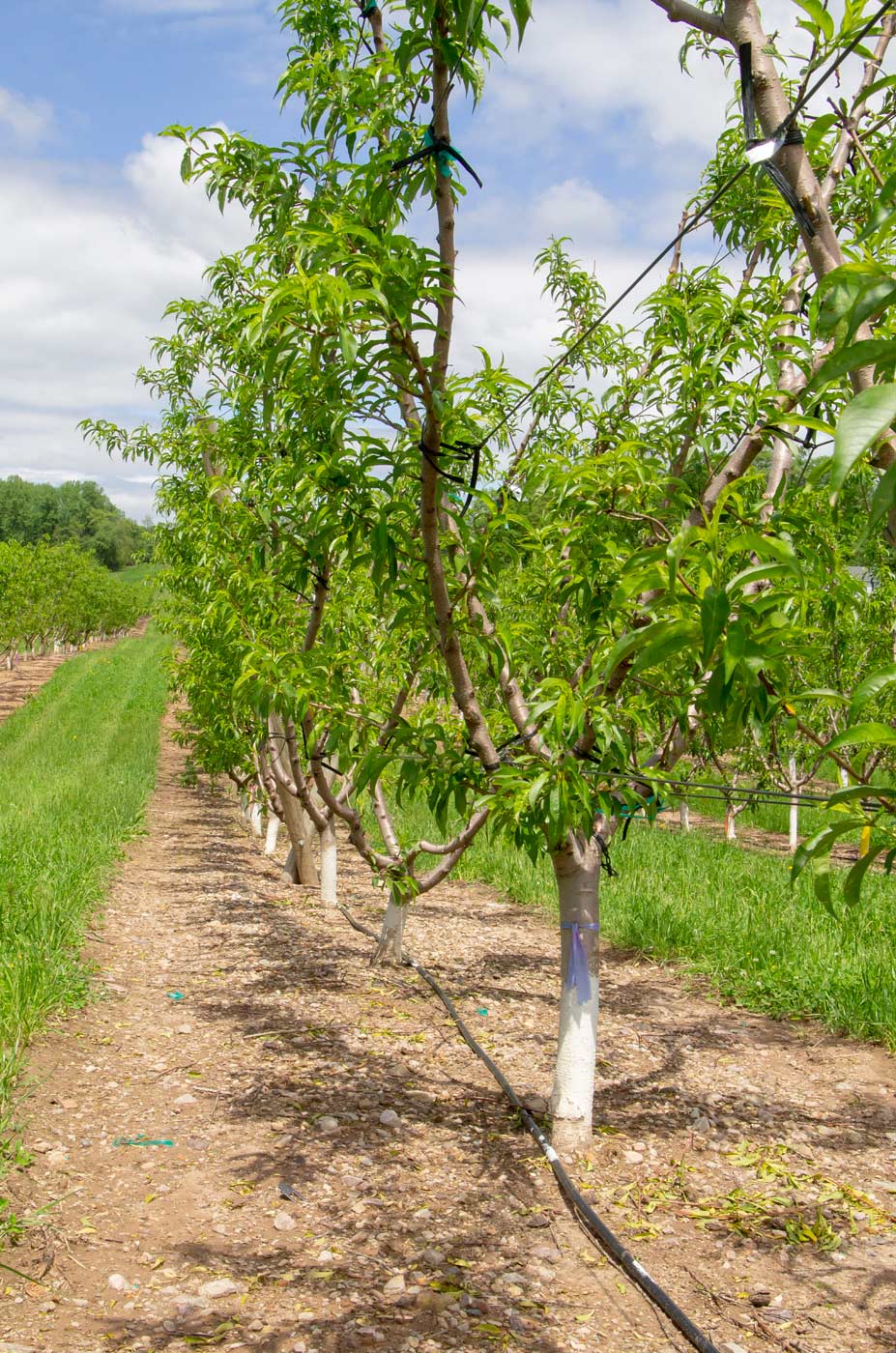
A trellised quad-V peach systems trial at the Penn State Fruit Research and Extension Center in Biglerville, Pennsylvania on May 23, 2018. Researcher Jim Schupp says this trellised system will increase yields from 350 bushels an acre to 650 bushels an acre. (Kate Prengaman/Good Fruit Grower)
Jim Schupp likes to plant his more provocative experiments right along the road so that growers passing by have a chance to watch. His latest peach orchard fits this “guerrilla extension” strategy because it challenges many of the region’s traditional peach practices, the Penn State University horticulturist said.
“Everyone knows you can’t grow peach trees on trellis,” he said with a smile, in front of a V-trellis block that supports four scaffolds per tree at the university’s Fruit Research and Extension Center in Adams County, Pennsylvania.
In the Mid-Atlantic region, growers are increasingly adopting high-density plantings for apples, but by and large, they still plant peach orchards the same way their grandfathers did: pedestrian systems with about 130 open-vase trees per acre.
Schupp thinks that system is overdue for innovation, so for the past decade he’s been testing out a variety of rootstocks, spacings and systems to increase yield and simplify pruning. Previous trials pointed to a quad-V system as the best balance of productivity and cost, so now he’s testing trellises and, so far, he’s optimistic.

Trellis wire poses a risk to peaches, because it could create canker-prone wounds, so Schupp decided to use plastic microfilament to support his prototype peach trellis at the Penn State University Fruit Research and Extension Center in Biglerville, Pennsylvania. (Kate Prengaman/Good Fruit Grower)
“They really lend themselves to mechanization, because now you have a two-dimensional canopy with a V-shape, which the peaches are naturally adapted to. Plus, you get that nice uniformity of fruit color and quality, and the main thing is you get much higher yield,” Schupp said. “It takes our yield up from about 350 bushels an acre to 650 bushels an acre, which is not insignificant.”
He’s got plans to take things even further, collaborating with the center’s new agricultural engineer Long He on a new block they intend to mechanize as much as possible.
“I’ve cooked up this totally insane system so that the only labor we are going to need is harvest labor,” Schupp said. “We are going to prune them mechanically, we’re going to thin them mechanically, and it’s going to be a low-labor production system.”
“With peach, it’s very hard to renew the fruiting surface down in the lower part of the canopy. So we’re actually going to renew the scaffolds,” he said. “That’s the dream, OK. Will there be problems with it? Of course. But it’s research and we’ll learn.”

Traditional open vase peach systems create pedestrian orchards, which growers like, but production per acre is low. Seen in Adams County, Pennsylvania. (Kate Prengaman/Good Fruit Grower)
Peach country
Pennsylvania is the fifth largest peach producing state, after California, South Carolina, Georgia and New Jersey. Although peach acreage pales in comparison to the state’s apples, it’s an important crop because the region has the ideal climate for tree-ripened peaches that bring high prices at farm markets locally and in nearby cities.
Many local growers say they still prefer open-vase peach orchards, because they see the benefits of the ladderless peach orchards outweighing increased density. At Bear Mountain Orchards, one of the state’s largest peach growers, experiments with high-density perpendicular V-system peaches with two scaffolds produced really tall trees that are difficult to manage unless they opt to invest in platforms, farm manager Joy Cline said. So, they stick with open centers.
But just down the road from the research center, Corey McCleaf grows his peaches in a six-scaffold system called a hex-V that produces about 800 bushels an acre. He said the production system is easy to maintain and works well for managing vigor and increasing yields — producing 1,000 bushels an acre in 2016 — but to really make the system shine, he’s waiting on Schupp’s results.
“What I need now is a trellis,” McCleaf said. That’s because it’s slow going using a string thinner on each scaffold, adjusting for their position. In Schupp’s regimented rows, the tractor operator with the string thinner goes twice as fast as in the free-standing blocks, he said.

A Hex-V peach system produces over 800 bushels an acre for Adams County grower Corey McCleaf. (Kate Prengaman/Good Fruit Grower)
The need for trellis was an obvious after a Penn State trial of high-density systems originally developed in California found that quad-V and hex-V systems, planted at 346 trees per acre and 242 trees per acre respectively, are more profitable for the region, considering labor inputs and yields, than perpendicular-V systems at 484 trees per acre or open-vase systems with 173 trees per acre. Until a dwarfing rootstock proves itself — several promising options are currently planted in trials across the country — growers will need to use spacing and systems to increase yields.
“The medium density systems were the best for us, more economic value and more efficient use of the land, plus redder fruit and higher yield per acre,” Schupp said when he shared results of his research with attendees at the Great Lakes Fruit and Vegetable Expo in Michigan in December. “Because we’re growing a larger tree, the highest density system is not the best one. The system that puts the most scaffolds per acre is going to be the best.”
Putting those scaffolds into a two-dimensional fruiting wall requires trellis wires, something long believed to be impossible with peaches, due to the risk of wounds that could invite canker pathogens. So Schupp used an 8-guage monofilament.
“Well, it’s been here since 2014, and, knock on wood, I have yet to see a single canker in here,” he said. But, just a graze from pruning shears is enough to break the filament, so he plans to test a plastic-coated steel wire in the next iteration of the system, to be planted later this year.
The trellis trial also features a combination of rootstocks and spacings. The trees are planted at 5 feet, 7.5 feet, and 10 feet and “the tighter you put them, the smaller they get,” Schupp said.
The rootstocks are Bailey, the industry standard in the Mid-Atlantic, which is just a little too big; Guardian, the standard in the south; Krymsk 86; KV 10123; and Penta, which is the most size-controlling of the bunch. Unfortunately, the Controller series of size-controlling rootstocks weren’t available when this trial was planned, Schupp said, but he’s optimistic about what he has seen from them in newer plantings.
This year, a hailstorm wiped out most of the fruit, but the first few years of yield data on the young trees have been promising. “The bottom line is that they’ve all been really good; there’s no losers in the bunch,” he said.

Peaches grown in a V-system can get quite tall, making management and harvest a challenge, as in this block at Bear Mountain Orchards in Adams County, Pennsylvania. (Kate Prengaman/Good Fruit Grower)
What’s next?
The remaining challenge is renewal. Peach trees need lots of light or the lower sections of scaffold will stop producing fruiting laterals, and over time production moves higher and higher up the trees. That’s why extensive summer pruning is key to maintaining open-vase systems.
“A grower friend said to me, ‘I’ve noticed that peach trees have about 7 feet of productive canopy. I’d like that 7 feet from 3 feet to 10 feet, can you do that?’” Schupp said.
To try to do just that, he’s decided to try renewal pruning on one side of his quad-V system at a time. He’s emboldened to try the idea after watching one of his older trials be converted for use by the center’s pathologist, who needed a consistent system for fungicide trials. Orchard managers cut all the trees off, spurring vigorous new shoot growth from which they trained new scaffolds.
With that orchard serving as proof that it’s possible, Schupp and the engineer, He, want to design a system that does the winter pruning with the “one-cut method,” using a machine to loop everything on one side off after four years. The summer before that renewal cut, they’ll be able to replace tedious summer pruning with a pass with a mechanical hedger to get more light into the canopy without worrying about the impacts to the short-lived scaffolds.
“Long and I are going to have a lot of fun with that orchard,” Schupp said. “If you aren’t shaking people up, then you aren’t a doing your job as a researcher.” •
—by Kate Prengaman






This system looks very interesting and promising . I would be interested in more detail- wire spacing, trellis construction, scaffold development. Would it be possible to get contact info for researcher?